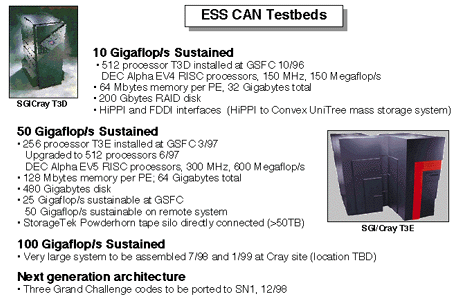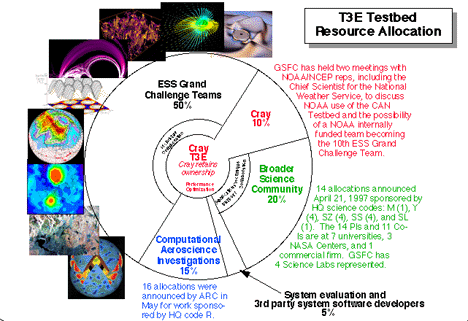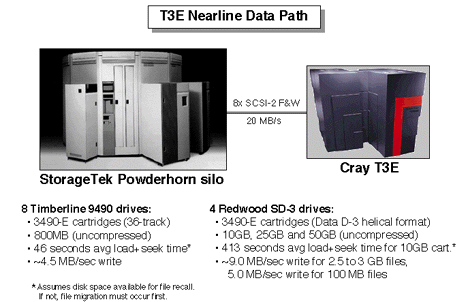

To provide hardware and software resources and accompanying support to enable Cooperative Agreement Grand Challenge Investigator teams to achieve ESS Project milestones of 10, 50, and 100 Gigaflop/s sustained performance on application codes and to provide leading-edge computing facilities to the general Earth and space science, space flight, and aeronautics communities.

Under NASA Cooperative Agreement NCCS5-135, Silicon Graphics/Cray Research installed a 512-processor CRAY T3D in October 1996 to enable each Grand Challenge team to meet the 10 Gigaflop/s sustained performance milestone by March 1997. At that time, the T3D was replaced with a 256-processor CRAY T3E, which was upgraded to 512 processors in June. The CRAY T3E was officially named for Dr. Joanne Simpson, GSFC's Chief Scientist for Meteorology, at a May dedication ceremony. In addition, the ESS Project procured and installed a StorageTek Powderhorn silo with eight Timberline and four Redwood tape drives, which are directly attached to the T3E running Cray DMF software. This silo will remain Government property at the conclusion of this effort.
Twenty percent of the system resources were allocated to the general Earth and space science and space flight communities through a proposal process. Fifteen percent of the system resources were allocated to the HPCC/Computational Aerosciences (CAS) Project. All awarded teams were integrated into the GSFC computing environment. The ESS Project hosted various Cray training classes and seminars on T3D and T3E Applications Programming, and provided help desk support and SGI/Cray applications support personnel to work with the selected groups.

Click on the desired category for more information.
Create an acquisition vehicle with the flexibility to allow the vendor to provide whatever systems they deem necessary to meet the milestones. Tie payment to achievement of milestones, not specific resources. Procure additional support peripherals as necessary to improve performance and protect the scientific investment from removal of specific systems. Train the user community to effectively use the resources.
The resources provided by SGI/Cray enabled the ESS Project to achieve the HPCC milestones "10-50 Gigaflop/s Sustained on Baseline Investigator Codes" and "50-100 Gigaflop/s Sustained on Investigator Codes with Optimized and Advanced Kernels" during FY97, which led to key scientific advances. Further, the ESS Project began preparing the general Earth and space science and space flight user communities for next-generation computing platforms. The ESS Project also provided resources to the CAS user community during their transition from the IBM SP2 testbed to a future system.

The CRAY T3E will continue to be available through FY98 and into FY99. SGI/Cray will enable all Grand Challenge teams to meet their 50 and 100 Gigaflop/s sustained performance milestones. SGI/Cray will continue to provide support to the T3E user community, including the broader Earth and space science users. They will also provide access to larger T3E configurations at remote sites for the Grand Challenge teams. Additional solicitations for use of the T3E will be released biannually, and additional training will be provided.
Lisa Hamet Bernard
Goddard Space Flight Center
Lisa.Bernard@gsfc.nasa.gov
301-286-9417
Table of Contents | Section Contents -- Testbeds